|
The flute,
nagaswaram, veena, gottuvadhyam, thavil, mridangam and the plain
drum are some of the ancient musical instruments of India. The
sitar, tabla and violin come late than the other musical
instruments. Except for the Veena, which is neatly fretted, all
the instruments are negotiated by the method of trial and error.
Their handling depends on the ingenuity and dexterity of the
player. The Veena, gottuvadhyam, sitar and sarod, the stringed
instruments are from Afghanistan.
|
|
|
|
|
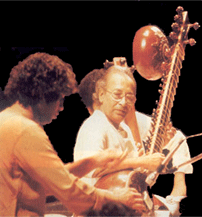
|
The Sitar is a
musical instrument which was invented by the Amir Khusrau, a courtier of
Allauddin Khilji in the 13th century. The name Sitar
was derived from Persian ‘Sehtar’ which means ‘three strings’
which the instrument originally had. But the modern
Sitar has seven strings fastened to the pegs on the neck and the
sides. Sixteen to twenty two frets are secured to the
finger-board by pieces of gut. There are also 11 to 12
sympathetic strings below the frets, running parallel to the
main strings. The instrument is played by means of a wire plectrum worn on the forefinger of the right
hand. This musical instrument was helpful in bringing up the western
people towards the
Indian Classical music.
|
|
|
|
|
|
|
|
Sarod
has secured an important place in Hindustani Classical
Music for its deep and rich tone and a distinctive
sound. This musical instrument descended from the Rabab of the Middle East. Some believed that
this
instrument might have originated from the
Greco-Buddhist area of Gandhar (modern Afghanistan).
Sarod is
a fretless instrument with sympathetic strings. The
modern Sarod is made of wood with one end being
rounded and covered with parchment. There are six main
metallic strings fastened to pegs at the neck of the
instrument. It is played with a plectrum held in the
right hand while the fingers of the left hand are used
to play the notes.
|
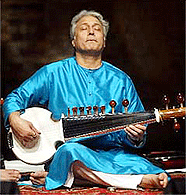 |
|
|
|
|
|
|
|
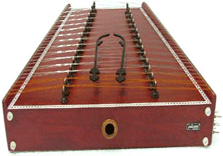
|
Santoor, which originated from the Vedic Vana Veena,
belongs to the Kashmir Valley that is neither
seen nor played anywhere else. But today, Santoor is played with all Indian ragas and is very
popular with the film musicians. The Vana Veena also had
strings and was played with sticks. The
modern Santoor is made of a trapezoid wooden box and
has thirty bridges and a set of four strings of metal,
tuned to the same note and stretches over each
pair of bridges. It is
played with a pair of flat wooden pieces curved at the striking ends.
|
|
|
|
|
|
|
Sarangi
is another stringed instrument, popular mainly as a folk
instrument and appeared first probably in the
late 17th century. The ability to play all types
of gamakas gave it prominent place in the Hindustani
Classical Music. The tone of the Sarangi is like the human vocal
chord. The player places the instrument on the lap and
plays it with a horse – hair bow in the right hand and
fingers and nails of the left hand. It is made
by hollowing out a single block of wood and covered by
parchment and has four strings. Four tuning pegs are fixed
to the hollow head and a bridge is placed on the
hide-covered belly in the middle.
|
 |
|
|
|
|
|
|
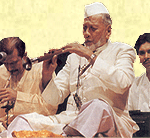 |
Shehnai, said to be of Persian origin, is considered to be an auspicious instrument
that belongs
to the category of wind instruments. It is a one-reed instrument with six
holes that yields soft and melodious sound. Shehnai is made
up of a
smooth dark-grained black wood, whose tube narrows on
the top and widens towards the bottom affixed in a cup.
All the
tunes of full tone, half tone and sharp notes can be
played on this instrument through breath control. The
notes are continuous and is generally used in classical
and light classical music.
|
|
|
|
|
|
|
|
There are various
stringed instruments in the Indian
Classical music, but the Violin has been recently introduced in it. In fact,
Violin is the only western musical instrument which has been
absorbed completely into the Indian classical music. It is said that about a
century ago, Varahappaya, a Minister of the Maratha rulers of
Tanjore, explored Violin to enrich Indian Classical Music. The strings of the
Violin are tuned to different notes in comparison to the western
style. The light tone of the steel string and the deep, almost
human tone of the fourth string embellishes the peculiarities of Carnatic music.
|
 |
|
|
|
|
|
|
|
Nagaswaram,
a popular wind instrument, was well
known in the 15th and 16th centuries and
formed an integral part of the temples. It
is believed that this instrument evolved from the snake charmer’s Pungi. It consists of a wooden
mouthpiece into which the player blows the air. This air under
pressure is released from the lower end of the gourd through two
bamboo or metal pipes. These tubes have a valve that controls
the flow of air through the pipes and have holes that control the melody. Nagaswaram often attains a wild beauty and softness and brings
out the subtle graces of the Carnatic music.
|
|
|
|
|
|
|
|

|
Flute, commonly
known as the Bansuri, is the wind instrument of
ancient India and was very common with Lord Krishna and the
religious music of the Buddhists. The frescoes of Ajanta and
Ellora depicts that this flute was also accompanied in the vocal
and instrumental music. It
is made of cylindrical bamboo pipe of uniform bore that
contains six holes for movement of the fingers and a bigger hole
for blowing air.
|
|
|
|
UP |
|
|
|
The Vichitra
Veena, a rare instrument of the North was introduced by Ustad Abdul Ajij Khan, a court musician at Indore.
This instrument is of a recent origin and is played by a
plectrum placed on the right hand finger. It has a broad stem and six main
strings are fastened to wooden pegs fixed to the other end. The
Southern Veena was introduced by Raghunatha Naik, a ruler
of Tanjore. This Veena consists of twenty four fixed frets
and the body is
hollowed out of a block of wood.
|
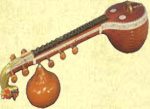
|
|
|
|
|
|
|
|
Ghatam is one of the ancient percussion instruments, often heard in Carnatic Music concerts.
Ghatam is a mud pot carefully kneaded and uniformly fired. The mouth of the Ghatam is open and is played
with two hands, wrists, fingers and nails. The mouth is pressed
against the stomach so that when strokes are given, the air
inside is set in vibration and gives a deep tone. The player can
produce various volumes and tonal colors by giving the finger
strokes at the neck, center and bottom of outer surface.
|
|
|
|
|
|
|
|
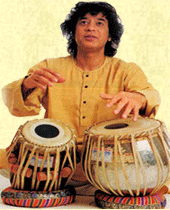
|
Tabla,
is evolved from the oldest percussion instrument, the damru of
Lord Shiva. It is believed that Tabla was invented by the Amir
Khusrau, a
courtier of Allauddin Khilji in the 13th century. It
is derived from a kind of Arabian drum called Tabla. In the hands of
a master, Tabla is capable of producing all patterns of rhythms
with well-established time cycles (talas). There are two pieces of Tabla
which
are generally tuned one octave apart. One is Dayan or the Tabla made of black wood
and other is Bayan or the Duggi made of wood, clay or
copper. Both are hollowed
from inside and covered with skin fastened to leather straps
which are stretched over the body of the drums by means of
leather braces. These straps are pulled to raise or lower the
pitch.
|
|
|
|
UP |

